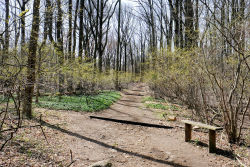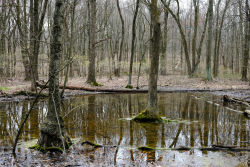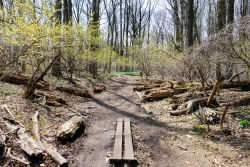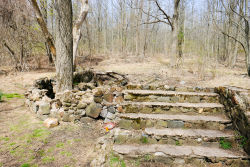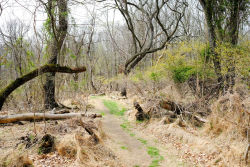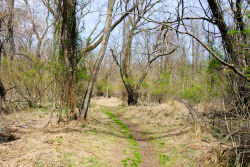LaTourette Park & Golf Course
LaTourette Park
LaTourette Park, like much of the surrounding area, was once the farm property of David (1786-1864) and Ann (1794-1862) LaTourette. The LaTourettes first established their farm in 1830. Over time the farm became one of the top producing family-run farms on Staten Island, renowned for its superb produce. In 1928, the LaTourette family sold their farm to the City of New York. The site was transferred to Parks in 1955 and was designated a New York City Landmark in 1973. Although the original farmhouse was demolished, the LaTourette’s 1870 mansion is now used as a club house for the park’s golf course. In 1982, the mansion was added to the National Register of Historic Places.
During the Revolutionary War (1775-1783), the British used the scenic ridgetop of present-day southwest LaTourette to watch for approaching American troops. The “blue trail” in the park takes walkers to this panoramic view that overlooks Richmond Creek. Near the Rockland Avenue and Brielle Avenue intersection are the serpentine uplands of Heyerdahl Hill. Here one can still find remnants of the Heyerdahl family’s fieldstone walls, fruit trees and grapevines. Unfortunately, little information exists about the Heyerdahl family and their vineyard. According to the existing records, the family stopped producing wine when Prohibition began in 1920.
Near the foot of LaTourette Park, at the intersection of Richmond Hill Road and Arthur Kill Road, lies the Richmondtown Restoration, a reconstructed village that embodies four centuries of Staten Island history and culture. Parks ceded several parcels of land for this purpose in 1956, and the tract of land was incorporated as Richmondtown in 1960.
In the northeastern section of LaTourette Park is Bucks Hollow, originally known as Boks Hill. “Bok,” the Dutch word for goat, references the goats that grazed on the hill in the seventeenth and eighteenth centuries. This area of the park is a habitat for the tiny Spring Peeper frog (Pseudacris crucifer), and the lesser-known Gray Tree frog (Hyla veriscolor). The Gray Tree frog was reintroduced in 1998 as part of Project X, an initiative that has brought endangered species of flora and fauna back into New York City’s parks. Sponsored by the Urban Park Rangers, Project X also reintroduced Screech Owls (Otus asio), Baltimore Checkerspots butterflies (Euphydryas phaeton), Wood frogs (Rana sylvatica), and such plants as Sweetfern (Comptonia peregrina), Skunk Cabbage (Symplcarpus foetidus , and American Columbine (Aquilegia canadensis) in 1998 and 1999.
LaTourette Park is a section of Staten Island’s Greenbelt, one of the borough’s flagship parks. Established in 1984, the Greenbelt forms a nearly contiguous circle of publicly and privately owned green space in the center of Staten Island. At 2,800 acres, the Greenbelt is the largest park under municipal jurisdiction. Much of the Greenbelt’s territory is preserved in its natural state, harboring a wide variety of plants and animals. Roughly twenty-eight miles of hiking trails wind through the Greenbelt. The Greenbelt also contains the High Rock Environmental Center and Greenbelt Headquarters, Greenbelt Native Plant Center and The Victory Plant Center, the William T. Davis Wildlife Refuge, LaTourette Park, Willowbrook Park, and six parks in Greenbelt Natural Areas. The Greenbelt Conservancy, Inc., formed in 1989, protects and cares for the Greenbelt, sponsoring numerous environmental education programs and festivals.
The LaTourette Park section of the Greenbelt has a diversity of forest habitats. These woodlands and wetlands provide a crucial preserve for flora and fauna threatened by the pressures of urban development. All four of the main hiking trails that run through this park are maintained by members of the Urban Trails Club. Today, LaTourette Park is home to such activities as hiking, golf, model airplane flying, and softball.
Check out your park's Vital Signs
Clean & Safe
Green & Resilient
Empowered & Engaged Users
Share your feedback or learn more about how this park is part of a
Vital Park System

